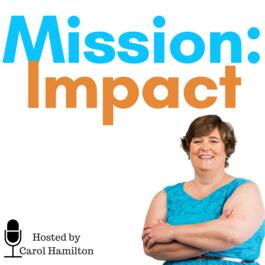
Nonprofit Success: Using Logic Models to Showcase Impact and Improve Organizational Alignment
In episode 108 of Mission: Impact, Carol Hamilton explores how nonprofit leaders can measure and map their organization’s impact through building out their theory of change and program logic models. I explain: That you already have a theory of change, even if it hasn’t been formalized. how making these models explicit not only helps funders and stakeholders understand the value of an organization's work but also aligns teams and improves programs. how organizations can better understand their programs, identify gaps, and articulate how their work drives meaningful change. How to practically put this into action Episode highlights: Every Organization Has a Theory of Change (Even If It’s Hidden) [00:02:32] - Hidden Theories of Change Carol emphasizes that every nonprofit already has a theory of change, even if it’s implicit. The challenge lies in making it explicit and shared across the organization to align efforts and strategy. [00:03:25] - Logic Models as Blueprints She explains how program-level logic models map out the necessary resources, activities, and expected outcomes, serving as blueprints for program implementation and evaluation. [00:04:49] - Building a Shared Vision Working together to create a Theory of Change and logic models not only reveals gaps in assumptions but also builds a shared understanding within the organization, strengthening cohesion. [00:07:12] - Practical Example: Watershed Organization Carol provides a concrete example of a local watershed organization, illustrating how they mapped out their programs in a logic model to address environmental education, citizen science, restoration, and policy work. [00:09:55] - Keeping Evaluation Simple She advises against overwhelming data collection, encouraging nonprofits to focus on a few key metrics that matter. This helps balance the workload and ensures meaningful learning from evaluations. [00:11:21] - Hypothesis Testing Carol describes the logic model as a hypothesis, where organizations can test assumptions and adjust programs based on data, making the process an opportunity for learning rather than a pass/fail exercise. [00:12:29] - Sharing Results with Stakeholders She highlights the importance of sharing results not only with funders but with all stakeholders, customizing communication based on the audience’s interests. [00:16:05] - Simplifying Program Evaluation Using the example of a peacebuilding nonprofit, Carol explains how she helped them streamline their evaluation process across different programs by designing a unified set of survey questions, enabling more effective data collection. [00:17:41] - Complexity of Systems Acknowledging the limitations of logic models, Carol encourages organizations to use them as tools to capture a slice of reality and proceed with realistic expectations. [00:18:56] - Encouragement to Invest in Evaluation Carol encourages nonprofits to invest time in building their Theory of Change and Logic Models, emphasizing that these tools help align strategies, reveal gaps, and strengthen program evaluation. Related Episodes: Episode 17 Program evaluation Episode 76 Getting clear on your theory of change Be in Touch: ✉️ Subscribe to Carol’s newsletter at Grace Social Sector Consulting 💻 Give us feedback on the show 👥 Like what you heard? Please share the podcast with a colleague or friend 🌟 Help more people learn about Mission: Impact by leaving a rating & review. 😀 Follow Carol Hamilton ➡️ LinkedIn
From "Mission: Impact"


Comments
Add comment Feedback